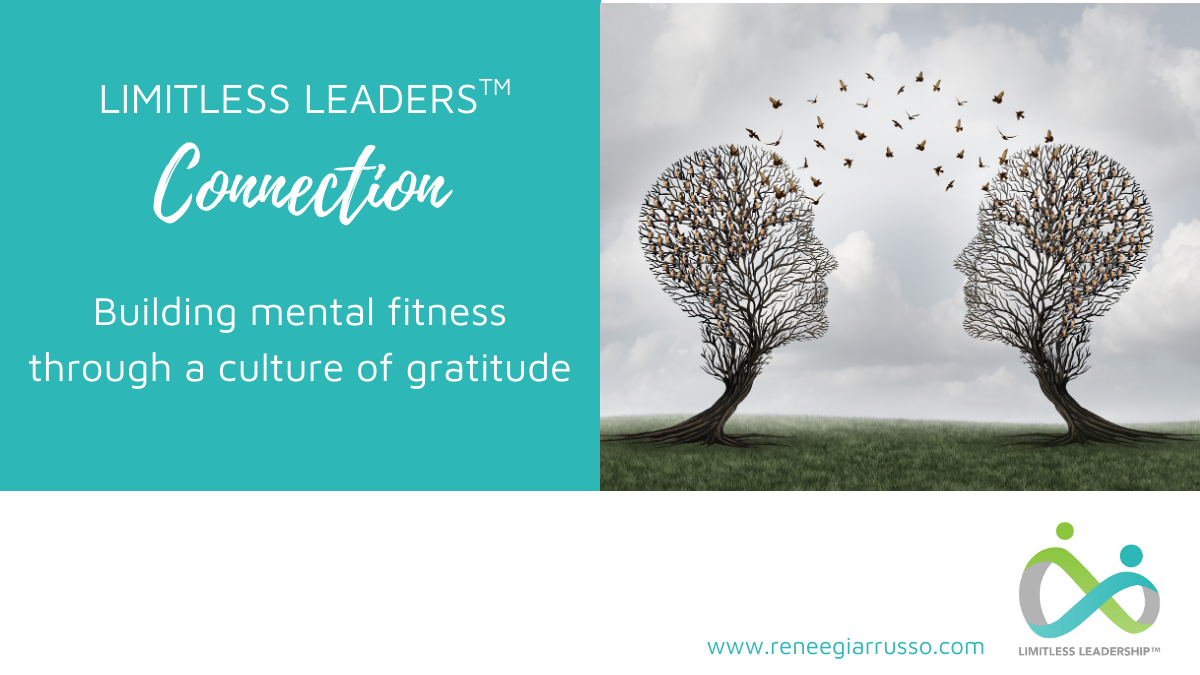Gratitude is not only the greatest of virtues, but the parent of all others.― Marcus Tullius Cicero
Over the last few months with many leadership teams, we have explored the topic of gratitude and how this is being expressed in the workplace. Call it recognition, praise or appreciation; what stood out is that we need to take the time to show gratitude within and across the teams, we work with.
Many organisations focus on a ‘performance culture’ and not a culture built around gratitude. This can affect the level and deepness of gratitude that employees practice. I call this ‘grey gratitude‘, it may not be intentionally stifled but it’s not hitting the mark as part of what makes up the culture.
If you are looking for employees to go beyond the contractual obligation of their roles and build mental fitness, then expressing gratitude should be part of your leadership. Acknowledging the thoughts and efforts of people with gratitude shows that those people matter and this can build a culture around gratitude which I believe is vital.
Research shows that taking the time to develop an attitude of gratitude can:
- Build a psychological immune system, making us more resilient to stressful situations
- Accelerate positive emotions
- Create a greater sense of achievement of goals
- Fewer sick days and less stress
- Greater collaboration and connection
- Higher job satisfaction overall
What gets in the way?
Many times, people feel awkward practising gratitude and may see it as fluffy and esoteric. The leadership team may not be on board and therefore don’t foster openness and space to build this practice into the culture. Another key blocker is people may see gratitude as a weakness and may feel left out if they don’t receive gratitude in return. Many simply don’t adopt the mindset.
We spend one-third of our life at work, that’s over 90,000 hours so it makes sense to incorporate the gift of gratitude into your workplace.
Gratitude can connect people. It can create collaboration and anchor positive behaviour and it’s also one of the collective skills that make up resilience.
Feelings, actions and our mindset flow from the way we look at the world and how we think about the situation – to change our feelings, we can start by thinking about what we are grateful for. Often, we find our feelings scary and confusing, so we keep them at a distance. However, shutting off our feelings not only backfires, but it drains us of the psychological energy that is needed to build resilience. We need our feelings in order to find satisfaction, meaning and pleasure in life, both in and out of the workplace.
Gratitude can maximise happiness in multiple ways, and one reason is that it helps us reframe memories of unpleasant events in a way that decreases their negative emotional impact and lets in optimism. We can let challenges deepen the way in which we are grateful – it can show us not to take things for granted.
Looking back is about learning and looking forward is about progressing.
Accessing and sustaining positive emotion is key to building resilience in organisations, needed now more than ever. Focusing our attention on how far we have come can provide positive reinforcement and fuel with our thoughts to overcome challenges and setbacks. It’s like looking in the rear-vision mirror of a car – what you pass goes by quickly, but it’s easy to miss a beautiful landmark or a life lesson that you could share.
Think about how you could flip what I call “Grey Gratitude” in your workplace to a clearer vibrant practice?
We have workshopped this question in a few companies and I’d love to share a few ideas and tips:
Share 1 situation or person you are grateful for
- Kick off a meeting/workshop/project review with each person sharing who or what they are grateful for in the workplace
- An option is to capture these on Yammer/Teams
3 positives to 1 negative
- For every negative, you or the team discuss, workshop 3 positives
- This reinforces the face we often focus on what isn’t working instead of the things we could be grateful for
Create a Gratitude wall-virtually or in the office
- People can leave notes of appreciation for anyone
- Name can be shared, or this can be anonymous
Ask a question
- What capabilities, qualities and skills have got me to where I am today?
- Individually of self or share as a team
Be specific
- When we aren’t specific when expressing gratitude this dilutes the impact and intention
- Imagine replacing “I’m grateful for that” to ‘I’m grateful for the support you have given the team and I this month”.
It is ideal to have structured forums to share as well as spontaneous recognition and ways to show appreciation. Some subtle ways of sharing gratitude every day could be as simple as sending surprise emails to others expressing appreciation or creating a forum to share internal updates and encourage people to share.
Be mindful not to do ‘gratitude’ in overdrive – this can seem false and dilute the effects of authentically being grateful.
I would love to hear how you are incorporating gratitude in your workplace!
Lead to be limitless…


